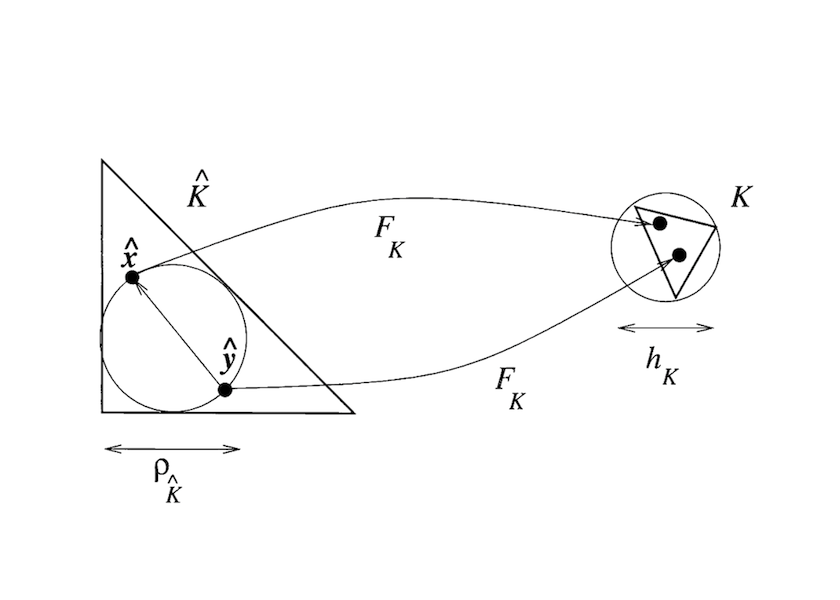Well-posedness of IVPs
This is a study note on the IVPs from Kreiss and Lorenz [3].
Introduction
We consider the well-posedness of the initial value problems (IVPs) in the form\[ u_t = P(\partial /\partial x)u = \sum_{|\nu|\leq m} A_\nu\frac{\partial ^{|\nu|}}{\partial x_1^{\nu_1}\cdots \partial x_d^{\nu_d}} u,\tag{1}\\ u(x,0) = f(x),\]where \(x \in D := \mathbb{R}^d\) and \(u(x,t):D \times (0,\infty )\mapsto \mathbb{R}\) is the unknown. The initial function \(f(x)\) is smooth enough and has compact support over the domain. We write \(\|\cdot \|=\|\cdot \|_{L^2(D)}\) for short.
We consider the well-posedness of the IVP (1). First, we should clarify what is well-posedness, generally speaking, it states the solution \(u\) should continuously depend on the initial data \(u(x,0)\), that is there exist constants \(C>0,\alpha>0\) such that for any \(t>0\)\[ \|u(x,t)\| \leq C e^{\alpha t} \|u(x,0)\|.\tag{2}\]
Solution of the IVPs
Fourier transform is a powerful tool to solve PDEs, see [1, 3] for an introduction. Assume \(\hat{f}(\omega)= [\mathcal{F}f](\omega)\), then\[ \hat{f}(\omega) = \frac{1}{(2\pi)^{d/2}} \int_{D} e^{-i \omega \cdot x}f(x)dx,\\ f(x) = \frac{1}{(2\pi)^{d/2}} \int_{D} e^{i \omega \cdot x}\hat{f}(\omega)d \omega.\]
Suppose initial value is some given mode, dented by \(e^{i \omega \cdot x}\hat{f}(\omega)\), then the solution \(u\) to (1) can be represented by\[ u(x,t) = e^{i \omega \cdot x}e^{P(i \omega)t}\hat{f}(\omega),\]where \(e^{P(i \omega)t}\) is nothing but the Fourier transform of differential operator \(P(\partial /\partial x)\). The principle of superposition allows us to obtain the exact solution to (1):\[ u(x,t) = \frac{1}{(2\pi)^{d/2}} \int_{D} e^{i \omega \cdot x}e^{P(i \omega)t}\hat{f}(\omega) d \omega. \tag{3}\]
Well-posedness
If there exist constants \(C>0,\alpha>0\) such that\[ |e^{P(i \omega)t}| \leq C e^{\alpha t}, \quad \forall \omega \in D, t>0, \tag{4}\]then we from Parseval’s identity obtain\[ \|u(x,t)\|=\|e^{P(i \omega)t}\hat{f}(\omega)\| \leq C e^{\alpha t} \|\hat{f}(\omega)\| = C e^{\alpha t} \|f(x)\|.\tag{5}\]It can be shown that the converse is also true. That is (4) is a necessary and sufficient condition for stability estimate (5). To see it, we need to show given \(\|u(x,t)\|\leq C e^{\alpha t} \|f(x)\|\), there holds (4). We give full proof in the following.
Begin of the proof
To show (4) is to show the matrix operator \(e^{P(i \omega)t}\) is bounded from above. General proof would start with the definition of an operator \(T\): \(\sup _{v} \frac{|Tv|}{|v|}=\gamma\). However, one could also show by choosing a special sequence \(v_j\) such that\[ (1-\epsilon_j) |T| |v_j| \leq \gamma |v_j|,\]which also implies \(|T|\leq \gamma\).
Another technique is that \(\|\hat{f}(\omega)\|\) is continuous for any \(\omega \in D\).we need to show \(|e^{P(i \omega_0)t}| \leq C e^{\alpha t}\), where \(C,\alpha\) are independent of \(\omega_0\). Using (5) we hope\[ \begin{split} C e^{\alpha t} \|f_j(x)\| &\geq \|u_j\| \quad (\text{from }(5))\\ &= \|e^{P(i \omega)t}\hat{f}_j\|\quad (\text{Parseval})\\ &= (1-\epsilon_j) e^{P(i \omega_0)t} \|\hat{f}_j\|\quad (\text{? }). \end{split}\]
To the end of the last step, we let \(\omega_0\) be fixed, and from the continuity of \(\|\cdot \|\), for any \(\epsilon_j>0\) there exists \(\delta_j\) s.t.\[ \|e^{P(i \omega)t}\hat{f}_j\|\geq (1-\epsilon_j) \|e^{P(i \omega_0)t}\hat{f}_j(\omega)\|=(1-\epsilon_j) |e^{P(i \omega_0)t}|\|\hat{f}_j(\omega)\|,\]where \(\hat{f}_j(\omega)=v\) for \(|\omega-\omega_0|<\delta_j\) and zero otherwise; and \(v \in \mathbb{C}^n\) with \(|v|=1\) satisfying \(\|e^{P(i \omega_0)t}\|=\|e^{P(i \omega_0)t}v\|\).
end of the proof
Generalization to \(L^2\) space
In the last section, we consider the initial data \(f\) of interest to be especially smooth, however, this can be extended to \(L^2\) space using density argument.
Let \(f_j(x)\to f(x)\) in \(L^2\)-norm, and from the estimate (5) we know there are solutions \(u_j(x,t)\) satisfy\[ \|u_i-u_j\| \leq C e^{\alpha t} \|f_i-f_j\| \to 0,\]which from weak convergence implies there is a solution \(u \in L^2(D)\) such that \(\|u_i-u\|\to 0\). Such solution \(u(x, t)\) in \(L^2\)-space is called the generalized solution of IVPs (1).
We give an example in [3, Section 2.2.5] that illustrates the process.
Example 1. For one-dimensional differential equation \(u_t+u_x=0\) with initial value \(u(x,0)=f(x) = 1\) for \(-1< x< 1\) and \(f(x)=0\) otherwise. We construct a sequence \(\left\{f_j \right\}\) that approximates \(f\) by\[ f_j(x) = \frac{1}{\sqrt{2}}\int_{-\infty}^{\infty}e^{i \omega x}\hat{f}_j(\omega)d \omega,\]where \(\hat{f}_j=\hat{f}\) for \(-j<\omega< j\) and zero otherwise. Then the solution with initial data \(f_j\) would be\[ u_j(x,t) = \frac{1}{\sqrt{2}}\int_{-\infty }^{\infty} e^{i \omega x}e^{-i \omega t}\hat{f}_j(\omega)d \omega =f_j(x-t).\]Take the limit and obtain \(u=f(x-t)\), which is not smoot but still belongs to \(L^2(\mathbb{R})\).
References
[1] Fourier 变换和 Laplace 变换.
[2] A short introduction to matrix exponentials. Numanal.com.
[3] H.-O. Kreiss and J. Lorenz, Initial-Boundary Value Problems and the Navier-Stokes Equations. Society for Industrial and Applied Mathematics, 2004. doi: 10.1137/1.9780898719130.


